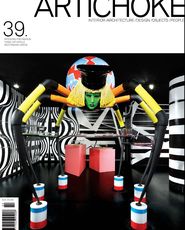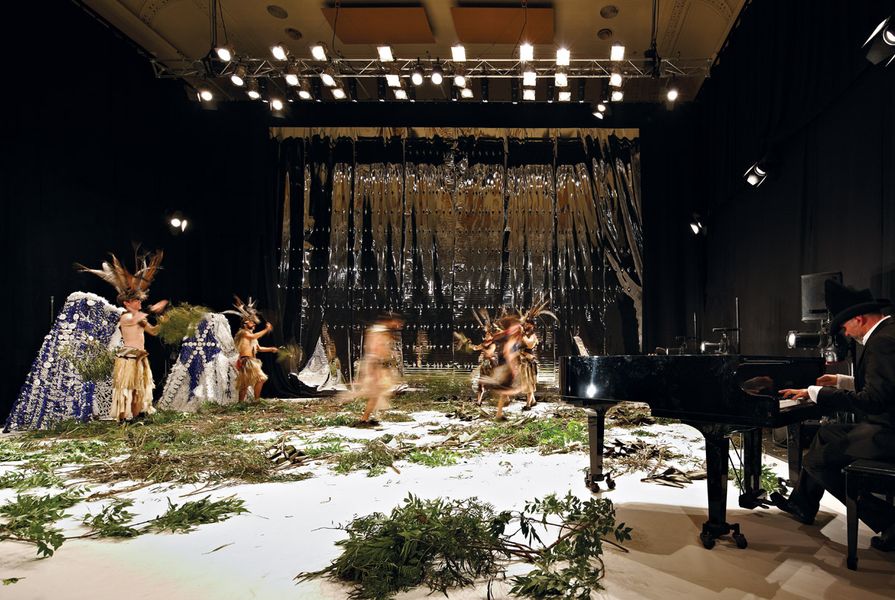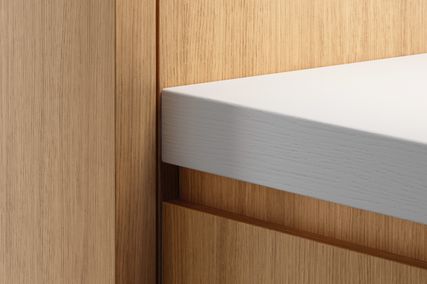There is a long history of architects crossing into the space of performance. We enjoy the freedom of the theatre as an often-experimental project without the pragmatic constraints and complex scale of more traditional forms of architecture. The abstracted world of performance provides an opportunity for designers to test out their larger, conceptual ideas with the absolute promise of feedback evidenced by audience responses and critics’ reviews.
Phillip Adams’ Balletlab is an extraordinary beast. Adams works at the edges of many practices and is adept at honing behaviour, sexuality and cultural practices to forge exciting, exquisite and sometimes difficult contemporary performance work. A Balletlab performance can often polarise audiences and yet, without doubt, a clear line of worship follows from significant corners of the artistic world. For Adams, this tension is a sure sign that he is doing something right.
In his most recent work, Aviary, developed in association with The Australian Ballet, Adams collaborates with Matthew Bird from Studiobird. Bird, a Melbourne architect (and recently appointed lecturer in interior architecture at Monash University), hails from a cross-disciplinary background. Bird deploys techniques that are commonly understood as an installation approach to speculate and meditate on his design research.Bird designed the backdrop for Aviary, along with the birds’ nests that appear in the third and final act, Paradis. He approaches the performative brief with a dynamism that is keenly reflective and process driven.
Bird and Adams met in 2008. Their like-mindedness was cemented by a shared love for Modernism (and the relatively unknown works of North American architect Bruce Goff). Bird describes theirs as a true collaboration, with the revered Adams always open to various interpretations of his method and objectives. Bird enjoys the intimacy and immediacy of the performative collaboration as well as the intensity of working alongside deeply creative folk.
These teepee-like structures are made of mesh, hose, netting and Circular trailer reflectors.
Image: Peter Bennetts
Aviary, for example, explores various dance languages and interprets the musical score of Olivier Messiaen’s piano suite from 1958, Catalogue d’Oiseaux. Adams draws on the delightfully designed bowerbird and the culture of the 1980s to mesh with an autobiographical thematic.
Bird’s backdrop is a scalar geometry that references Walter Burley Griffin’s transcendental approach to spectacular mass and repetition and, perhaps, conveys some of Bird’s early professional experiences with ARM Architecture and Cassandra Complex – practices that are rooted in an Antipodean sensibility.
The third act is a tribal, hedonistic scene where ritualistic habits are intensely interpreted by the performers. Adams himself sits at a piano as “conductor.” The nests are abstracted concepts that both parallel and reflect the manner in which the bowerbird obsessively collects human-made materials to create a nest and woo a mate. Here, Bird aims to develop more than a surface (or set, if you like).
The tepee form, suggests Bird, is a pure, or enlightened, form. The steel framework provides an infrastructure for the recycled, en masse collection of materials – a mountain of stuff foraged by Bird over a period of six weeks. The work is assembled via instinctual testing of the geometry and fixing of the individual parts. The result is a reflective and decorative piece.
In a quirky twist (and design test), the set pieces needed to fit into two portable suitcases: the backdrop fabric rolls up and the nest mesh folds and collapses, compact enough to be carried by the dancers on an international tour. For Adams and Bird, their collaborations will continue with a new project that is set to redefine the performer/audience relationship. No doubt the polarized public will continue to look! Eyes open for Balletlab 2012.
Products and materials
- Products
- Nylon bird netting, black creeper mesh, stainless steel washers and cable ties from Bunnings Warehouse. Circular trailer reflectors from Autobarn. Blue vacuum hose from MTQ Engine Systems. Powdercoated steel framing from Onset Arts Workshop. Backdrop is Rosco’s Silver Shrink Mirror. Green foliage sourced from the Royal Botanic Gardens Melbourne.
Credits
- Project
- Aviary
- Design practice
- Studiobird
Armadale, Melbourne, Vic, Australia
- Project Team
- Matt Bird, Jamie Smith, Holly White, Allie Mactier
- Consultants
-
General manager/producer
Amelia Bartak
Lighting design Benjamin Cisterne Design
Production manager Trafficlight, Tom Webster
- Site Details
-
Location
2/170 Southbank Blvd,
Southbank,
Melbourne,
Vic,
Australia
- Project Details
-
Design, documentation
6 months
Construction 2 months
Source

Project
Published online: 1 Jun 2012
Words:
Niki Kalms
Images:
Peter Bennetts
Issue
Artichoke, June 2012


















